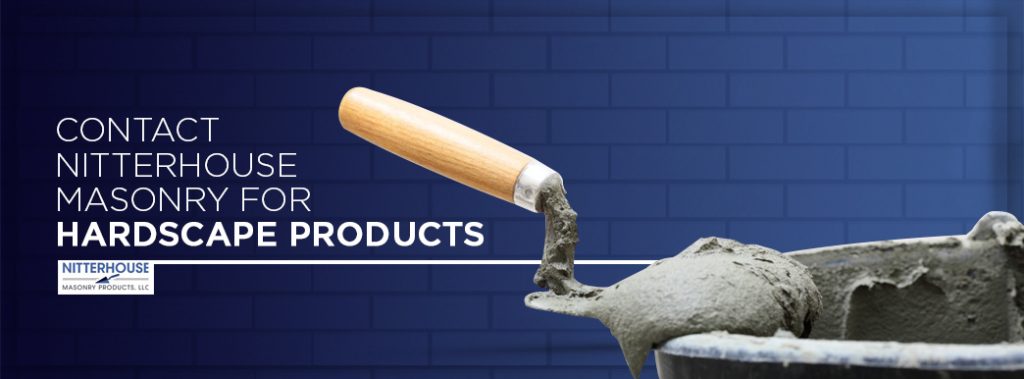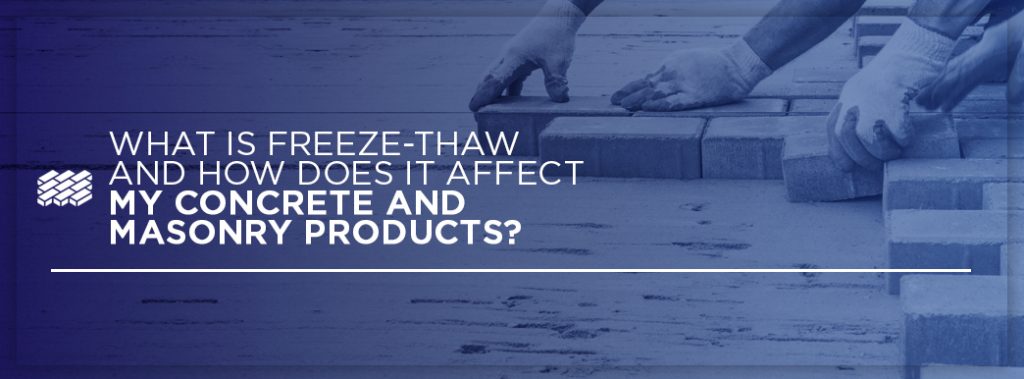
Jump-To:
- What Is Freeze-Thaw?
- Freeze-Thaw Cycles
- Effects of Freeze-Thaw on Outdoor Hardscape Products
- Hardscaping Elements
- Prevent Freeze-Thaw Damage
- 1. Using Deicing Chemicals
- 2. Reviewing Concrete Structure and Environment
- 3. Applying a Sealer
Concrete is durable, but there’s one substance that can wreak havoc on it if you aren’t careful: water. Water can cause freeze-thaw damage, making it a necessary consideration in masonry work. It can come in contact with concrete structures in a variety of ways — from rain to snow to dew to humidity.
Also called freeze-thaw weathering, this process has the potential to damage concrete or hardscaping elements. Luckily, there are several precautions you can take to keep your fixtures looking as good as new in the presence of cement freezing. This guide will help you understand freeze-thaw, what type of damage it causes and how you can prevent future freeze-thaw damage to your projects.
What Is Freeze-Thaw?
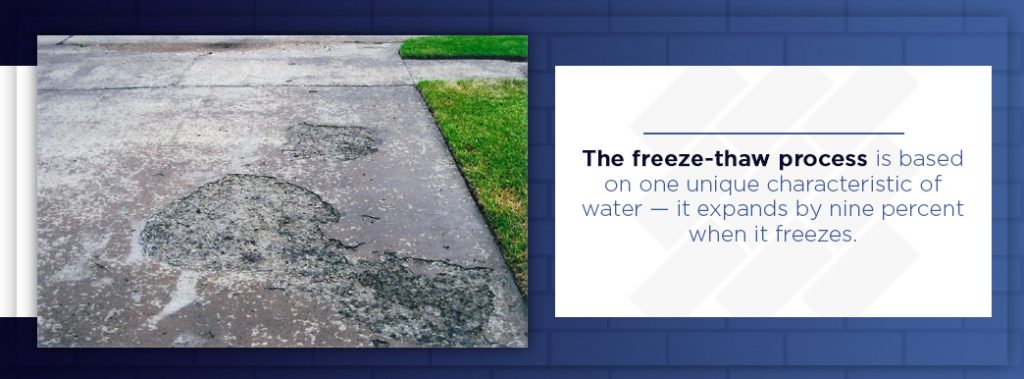
The freeze-thaw process is based on one unique characteristic of water — it expands by nine percent when it freezes. The cycle occurs readily in nature and is common where temperatures reach below freezing at night and rise in the daytime. However, freeze-thaw generally doesn’t happen in environments that don’t freeze at all, like the tropics, or stay frozen most of the time, like the arctic.
In a more moderate climate, water seeps into cracks and openings in rock during the day and freezes overnight. As the water freezes, it expands, stressing and opening the rock further and creating a wider gap. Generally, the most destructive kind of freeze-thaw action occurs in highly saturated conditions where more water is present.
You can freeze water in something like an ice cube tray, which allows the ice room to expand upward — but if water is stuck inside a non-flexible material, it will stress and eventually break it. When the ice melts as the temperature rises, it leaves a larger crack than before.
Freeze-Thaw Cycles
Once the crack has expanded, and the ice has melted, more water can fill up the gap in the rock. Since the crack is bigger, it can hold more water this time around. Once the temperature drops again, the new water freezes and the crack gets nine percent larger than before. Each time this cycle occurs, the crack gets bigger and bigger.
This process, also known as frost wedging, eventually causes the rock to break off into smaller pieces and separate from the larger stone, eroding it little by little. This erosion frequently occurs in nature in mountains and canyons. Scree slopes, which are made of fallen rock pieces, often develop at the bases of cliffs and mountains due to freeze-thaw cycles. Freeze-thaw can also affect many human-made items in a variety of climates across regions and seasons.
A freeze-thaw cycle is a form of mechanical weathering, which means it doesn’t need to change the mineral makeup or molecular structure of the rock to wear away at it. Rust or oxidization, on the other hand, does cause a chemical change when they affect rock. With water, a rock is chemically identical both before and after freeze-thaw occurs. This physical weathering of concrete depends on the structure and integrity of a rock, not necessarily its chemical makeup.
Freeze-thaw cycles can occur daily in many climates where the temperature drops below freezing at night and rises above freezing during the day. If you’re thinking of adding concrete installations to your home or business, you’ll need to consider the possibility of freeze-thaw, as low-quality or ill-prepared concrete can be prone to more damage from freezing and thawing. Luckily, there are steps you or a contractor can take to minimize the effects of this cycle and keep the concrete in good condition.
Effects of Freeze-Thaw on Outdoor Hardscape Products
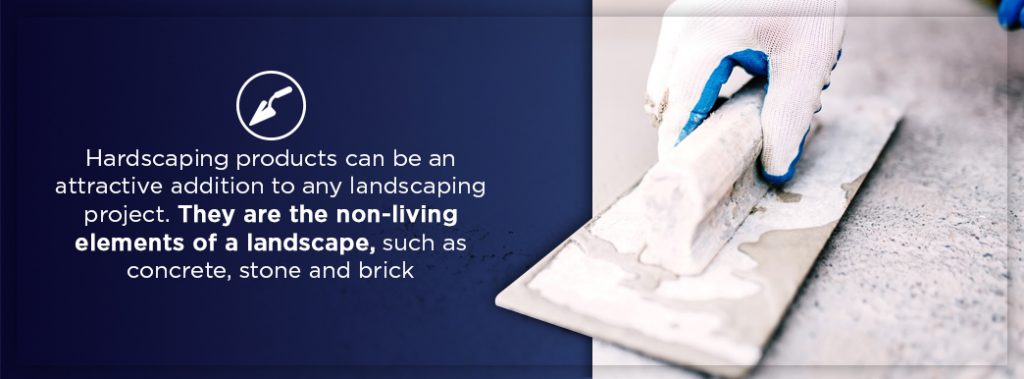
Hardscaping products can be an attractive addition to any landscaping project. They are the non-living elements of a landscape, such as concrete, stone and brick. Hardscaping pieces are often functional, as they typically provide seating, standing space and containers for plants. Hardscaping elements can include:
- Pathways
- Benches
- Driveways
- Patios
- Walls
- Planters
- Fences
Often, these elements are made of concrete or stone, both of which are subject to freeze-thaw and the damage that comes with it. Concrete functions similarly to rocks found in nature. It has pores running through it that hold water. Every time the water freezes, the pressure within the pores increases.
If that pressure becomes greater than the tensile strength of the concrete, it ruptures the cavity, breaking apart the pore and reducing the integrity of the concrete. As this accumulates over more and more pores, it causes deterioration, including expansion, scaling and cracking.
One significant type of freeze-thaw damage occurs from D-cracking. D-cracking refers to durability cracking, which occurs when numerous freeze-thaw cycles affect the coarse aggregate present in concrete. As water accumulates within the aggregate and in between the layers, the freeze-thaw expansion reduces the durability of the concrete. It begins cracking from inside the concrete, so it is often difficult to detect it until the cracks reach the surface.
Certain types of aggregate, like some sedimentary rocks, are more susceptible than others. However, unweathered igneous rocks are typically not susceptible to D-cracking. Usually, aggregates with several pores and small pore sizes are likely to experience D-cracking. Concrete at ground level can also be more vulnerable to this type of wear, as the surface is a prime location for water to collect.
The aggregate becomes saturated with water as it accumulates, often at the bottom of the concrete slab or fixture, and the cracking moves upward. D-cracking is different from other types of freeze-thaw damage because of its internal behavior.
Other types of water damage, like spalling or scaling, both occur because of built-up water on the surface. However, these usually only occur on the surface of the concrete. Typically, pieces will fall off as this occurs. Repeated spalling can still cause structural damage over time, but it is also much easier to identify — whereas, D-cracking is difficult to identify until it has already caused significant damage.
Besides D-cracking, you may find that freeze-thaw conditions can cause scaling in concrete. Scaling is the “flaking” texture that occurs when the top layer of concrete peels up. It can start as small patches that later grow. Scaling can differ in severity, from light scaling that doesn’t expose the aggregate to severe scaling that clearly shows the aggregate, peeling off significant amounts of surface mortar. Some causes of scaling include:
- Using concrete that is not air-entrained or air-entrained properly.
- Applying too much deicing salt on low-quality concrete, including that which was not mixed, air-entrained or cured adequately.
- Finishing concrete when bleed water is still present on the surface.
Hardscaping Elements
Hardscaping stands in a unique position. Many pieces are made with varying climates in mind, but the wrong blocks can fall away or crumble in no time in freeze-thaw environments, so contractors and builders must still make informed choices. Pavers, a substantial component of hardscaping efforts, are usually made of interlocking pieces that offer more resistance to the effects of the freeze-thaw cycle. They are typically denser and provide low permeability, which creates less room for water to enter. Freeze-thaw damage in pavers is less common because:
- They are less prone to cracks.
- They have spaces between them that allow rainwater to filter through.
- They have individual pieces that are easily replaceable.
- They provide more traction in icy conditions from the grooves between pieces.
Another helpful feature present in many hardscaping elements is the use of entrained air. Entrained air can help improve concrete’s freeze-thaw resistance. Air entrainment adds air voids to concrete. Empty chambers are intentionally left in the paste so water can move into them as it freezes and gains volume, accommodating this change by reducing the stress on the concrete. The chambers lessen the pressure buildup in the pores and can help keep damage at bay. They also help to lower the permeability.
It’s important to note that entrained air and entrapped air are not the same:
- Entrained air: Entrained air is the intentional addition of air pockets that are spread out uniformly and evenly throughout the concrete on a microscopic level. It is well-controlled, due to the impact it can have on concrete’s compressive strength. Specific standards are in place to keep the entrained air at appropriate levels.
- Entrapped air: This kind of air is usually a mistake. It occurs during improper mixing or pouring and consists of irregularly sized, large bubbles within the cement. Due to their shape and structure, they are ineffective against damage from the freeze-thaw cycle. These can negatively affect strength and durability, but vibration techniques can help keep them at bay.
Stones and bricks are other common components used in hardscaping that also get damaged from freeze-thaw cycles. They similarly will see more damage if they get more moisture. For example, if one side of a wall gets hit with wind and rain more frequently than another, it will probably see the most freeze-thaw damage. As sunlight exposure changes, it can also affect the temperature of the water and its phase changes.
Prevent Freeze-Thaw Damage
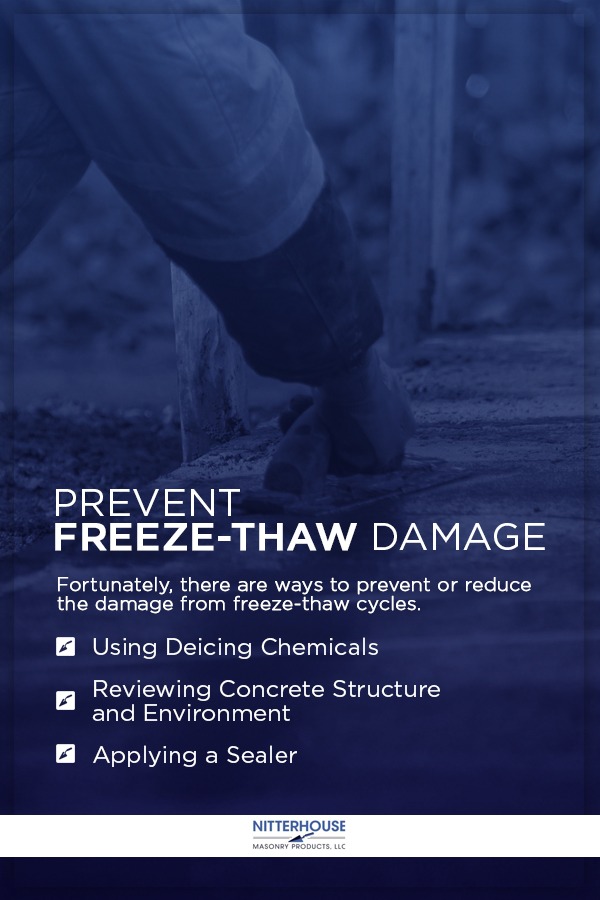
Fortunately, there are ways to prevent or reduce the damage from freeze-thaw cycles. The damage isn’t something you can readily fix. It usually requires completely replacing the damaged piece or brick, so preventing the damage instead is the ideal approach. Some common methods for preventing freeze-thaw are:
1. Using Deicing Chemicals
One of the simplest ways to prevent concrete freeze-thaw damage is with deicing chemicals. These chemicals typically use a mixture of certain compounds to reduce the freezing point of the precipitation significantly. If the freezing point lowers, the water remains in its liquid state and can pass through the concrete easily. It takes much colder temperatures than usual for it to freeze.
Sodium chloride is the most common mixture for ice-melting salt. It doesn’t have a significant chemical effect on concrete, but it can damage lawns and shrubbery and corrode metal. Most other chemical mixes have similar results, like calcium chloride, which may be harder to store — magnesium chloride, which releases less chloride into the atmosphere — and potassium chloride, which causes less damage to vegetation.
Some applications have specific requirements about the chemicals that can be present in a deicer. Most mixes with chloride promote the corrosion of metals, so places like airports need to use non-chloride deicers to prevent damage to an aircraft. Their options may include urea, a nitrogen product, or more organic potassium acetate, ethylene glycols or propylene glycols. Potassium acetate may be mixed with a corrosion inhibitor, as it is still slightly corrosive. It is also biodegradable and environmentally friendly.
2. Reviewing Concrete Structure and Environment
High-quality concrete can also help to prevent deterioration. Many blocks are made with features designed to reduce the effects of freeze-thaw or prevent it altogether. For example:
- Purchasing blocks with entrained air can help you ensure even dispersion of air and water, so the freezing doesn’t put as much pressure on the concrete.
- Low-permeability mixes help keep water from penetrating the surface as easily and keep it outside the blocks.
- High-strength concrete helps blocks resist structural damage from freeze-thaw processes.
- Smaller aggregates are known to perform better in freeze-thaw conditions.
A well-made piece of concrete can help keep freeze-thaw damage at bay, especially in the use of pavers. The environment, of course, can also influence freeze-thaw effects on concrete. Providing sufficient drainage underneath the concrete may help keep water from pooling at the base of and seeping into the rocks.
3. Applying a Sealer
Another way to prevent freeze-thaw in concrete is with a penetrative sealer. Since the saturation of the concrete is what causes water to build up, a concrete sealer can help make it more freeze-thaw resistant with a hydrophobic coating. It is fairly simple to install and can keep water from collecting within the pores of the cement.
However, this process needs to be done correctly, or you may end up with a cloudy, discolored layer, as water breaks through the sealant barrier. You should only install sealer after the concrete is fully cured, before deicing chemicals are applied, during dry conditions and before any freeze-thaw cycles can occur. Sealers are typically acrylic, epoxy or polyurethane-based, each with their advantages and disadvantages. They typically require warmer temperatures to set properly, so doing them before fall is usually best.
When selecting materials for hardscaping products, you’ll have to have a keen awareness of the freeze-thaw conditions to which they will be exposed. Select products that possess features to minimize problems with deterioration and freeze-thaw. Attending to freeze-thaw issues preventatively can save you from the destruction they cause later on.
Contact Nitterhouse Masonry for Hardscape Products
Choosing high-quality products is one of the most crucial parts of building hardscaping elements. The concrete must be strong, with low permeability and the ability to withstand repeated freeze-thaw cycles. Nitterhouse Masonry offers a wide variety of hardscape products that reach high standards of quality. Builders and contractors look to us when they need to create something that will last. We’ve been creating products that hold up in freeze-thaw climates for five generations.
When the temperatures get cold, then hot again, you can rest easy knowing your products are built to resist freeze-thaw damage. To learn more about our hardscaping products and which ones will work the best in a freeze-thaw environment, contact a representative today.


